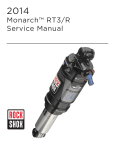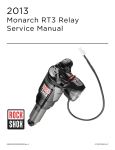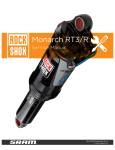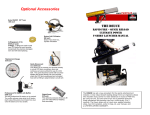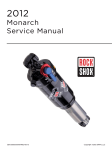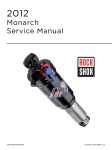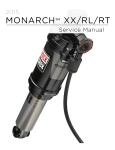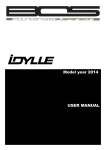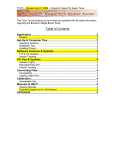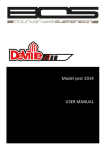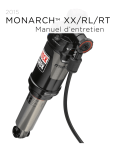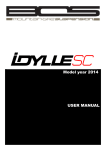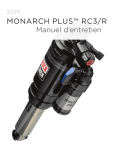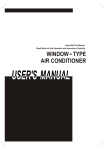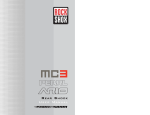Download Model year 2014 USER MANUAL
Transcript
Model year 2014 USER MANUAL WARRANTY Terms and conditions BOS MTB offers warranty on its products on the following terms : BOS MTB guarantees to the original purchaser that the BOS product for which they received this warranty is free from defects in material and workmanship for one year from the date of original retail purchase. A proof a purchase will be asked for any warranty claim. This warranty is not transferable to a subsequent purchaser. Wear and tear parts such as dust seals, Oring, bushings, rear shock mouting hardwares, stanchions, threaded parts and bolts are not covered under this warranty. Terms This warranty is subject to legal jurisdictional or warranty rights of the country where it has been originally purchased, which will prevail if different from the terms herein listed. Limits BOS MTB cannot be liable for any loss, inconvenience damages, whether direct, incidental, consequential, resulting from the use of its products, local legislation prevailing. Warranty exclusions This warranty does not cover the following cases: • Damage to products resulting from improper assembly other than listed below • Products that have been modified by the owner or a third party • Improper use • Damages resulting from an accident, crash under any circumstances • Invalid servicing procedures and servicing time frame not respected • Replacement of the original parts by parts from others manufacturers • Products whose serial numbers has been altered, defaced or removed. Warranty procedure The owner should always refer to an approved BOS center for any warranty claim. A proof a purchase is compulsory for any warranty claim. Otherwise the warranty claim will not be considered. Always contact BOS MTB warranty department before returning any products that may fall under this warranty. If “the faulty parts” do not fall under warranty, the customer will be charged for any costs in respect with warranty such as transport and package back and forth. 1. INTRODUCTION Thank you for purchasing a Bos KIRK shock. Your shock has been assembled specifically for one bike - obviously yours ! - which means that the internal valving and the air chamber volume are settled for your bike. The adequate mounting kit is also provided with the shock. CAUTION Never try to disassemble your shock. Limit yourself to the instructions given in this manual. This shock is pressurized, for your own safety, do not try to open it. Contact an authorized service center for any maintenance operation. 2. ASSEMBLY Your KIRK shock features adequate mounting kits for the bike mentionned while ordering. Check the mounting way by refering to the compatibility table, available on bos mtb website : http://www.bosmtb.com. Refer to the bike manual to follow the specific shock mounting procedures of your bike. 3. SETTINGS 3.1. AIR PRESSURE Before using the shock, you must set up the air pressure, depending on your weight. The air pressure is not only related to your weight but also to your bike’s rear suspension geometry. Refer to the compatibility table on Bos mtb’s website, in the download area : http://www.bosmtb.com to check the correct air pressure, related to your body weight and your bike.. Connect a pump equipped with a precise manometer to the Schrader valve located on the side of the upper part of the body, and inflate at the right pressure. air valve 3.2. AIR CHAMBERS BALANCE In order to guarantee a perfect functioning of your shock, after having set up the air pressure, you must proceed to the air chambers balance. The shock must be mounted on the bike. Place the O’ring at 11 mm from the seal of the shock, sit on your bike, and push slowly on the suspension, to compress the shock until the seal come onto the O’ring.Let the suspension extend itself, still slowly. Repeat 15 times those up and down movements, always at low speed. 11 mm 11mm 3.3. CHECKING THE SAG The SAG is the quantity of travel used while sitting on your bike, due to the effect of your weight. It has to be set up by adjusting slightly the air pressure. BOS recommends a percentage of SAG of 30 to 35 %. The bike manufaturer may also indicate a percentage of SAG. Please refer to your bike’s owner manual to check it. If the bike percentage differs from Bos advices, please test on the track which is the best setting for your riding style. How to measure and set up the SAG ? Slide the O’ring onto the seal of your shock. Sit on your bike (if possible dressed with your riding outfit) feet on the pedals - horizontal position, and let the sus pension compress under the effect of your weight. Get down from the bike, extend the rear suspension to the maximum by pulling up the saddle, and measure the distance between the O’ring and the seal. This distance will allow you to check the percentage of SAG obtained with the current air pressure. To convert the distance into percentage, refer to the table below. length x stroke (mm) 200x51 200x57 216x63 222x69 SAG (%) 30 35 30 35 30 35 30 35 SAG (mm) 15 18 17 20 19 22 21 24 If the SAG is not correct, slightly set up the air pressure, by 15 PSI steps. Too much SAG : increase the air pressure. Not enough SAG: reduce the air pressure. 3.4. HYDRAULIC SETTINGS The KIRK shock is a three-ways type shock, which means there are three types of damping adjustment: rebound, low-speed compression and high-speed compression + a lock out lever for low speed compression only. Your shock’s basic setting (internal) is designed for your bike’s geometry. We use ten basic settings which cover the majority of bikes on the market. If a different setting is necessary for a given bike, we will develop it especially. The purpose of damping adjustments is to use all the shock’s travel without bottoming-out (or only rarely), to give grip to the rear wheel, but also to stop the bike stalling in holes, and finally to maintain a good position. Below are the basic settings for your frame. Then it’s up to you to analyse its performance and adjust the settings to suit your riding style. Do this carefully and methodically, step by step. Only change one setting at a time and only by a few clicks. If it’s OK, note the setting and type of terrain. If you get confused with the settings, return to the basic settings and start again. 3.4.1. Low speed compression (A) and low speed compression lock out lever (B) The low-speed compression (A) affects the shock’s performance in compression over small bumps or through the beginning of the travel. It can be useful to make the low-speed harder (screw clockwise) on rolling terrain with big compressions and kickers. It can be useful to make the low-speed softer (screw anti-clockwise) on steep gradients. The lock out lever (B) acts on the low-speed compression and affect the threshold. It can be useful to lock it on pedaling section and uphill to maintain a good balance of the bike. 3.4.2. High speed compression (C) The high-speed compression acts mainly on harsh hits (jump landings, rough rutted sections). It should be soft enough to get all the travel without bottoming-out. If, on a given track, you bottom-out a lot, make the high-speed compression harder. However, don’t get hung up on bottoming-out if you only do it once or twice during a run. You risk setting your shock for 3% of the course and losing effeciency on the other 97%. If your shock doesn’t get full travel, soften the high-speed compression. 3.4.3. Rebound (D) The main factor in adjusting the rebound is the position of the bike. A downhill bike shouldn’t be ‘sat-down’ all the time, although the back does need to be fairly low. Playing with the rebound will allow you to keep this balance. If you feel like the back of the bike’s pushing you forward on a slope or when braking, increase the rebound (screw clockwise). It can be useful to accompany this adjustment (especially if the problem persists) by unscrewing the low-speed compression slightly. If, on the other hand, the bike seems too low at the back and/or the front end has a tendency to drift offline, reduce the rebound (screw anti-clockwise). C D A B Starting points adjustments whatever the inner setting Low speed compression : 15 clicks from the fully tighten position. High speed compression: 12 clicks from the fully tighten position. Rebound : 12 clicks from the fully tighten position. Refer to the Kirk charlist available on the download section on bosmtb.com for details about standard settings for each bike. CAUTION Thanks to a good compression curve, the KIRK shock allows the bike to keep a good balance, a good response and handling. Bos thus recommends to set up the bike with a fast rebound, to keep that chassis balanced, and avoid the bike staying low, which means that it will be less nervous, and less comfortable. The feeling of «fast» or «slow» rebound will be different from a rider to another one. Thus it’s difficult to define it precisely. It’s related to your riding style. We advise you to define your own range of correct rebound - the range of settings between «too fast» and «too slow». Then, always choose the faster part of that range, for example the three last clicks (unscrewing) on a range of nine. 3.5. AIR VOLUME ADJUSTMENT The progressivity adjustment featured on the Kirk, allows you to act on the air spring rate on the last third of stroke. Therefore, from satisfying settings (air pressure and hydraulic) on the first half of the stroke, you can act on the last mm of travel. The most featured and simple cases are : 1. The shock has an overal setup to single out comfort and grip,and the bikes is quite low : by increasing the rate you will get a better control of the châssis through the shock and avoid bottoming out. The rate curve is more progressive (increasing at the end). 2. The overal setup of the shock is more responsive, with a chassis balance quite high. By decreasing the rate, you can make sure that you use all the travel. This setting is made through the o’rings placed inside the air chamber, by adding or removing some. We suggest you to go step by step. At first play with two o’rings, then end the setting more precisely, with one o’ring. By adding one o’ring in the chamber, the spring rate will increase of 2%. Usually, the correct setting is made with 0 to 4 o’rings. But the range can go up to 10 o’rings depending on the bikes. CAUTION Use only the o’rings provided by Bos. The material and the dimensions are specific. Procedure 1. Install the shock in a vise using a soft jaws (picture 1) 1 2 3 4 2. Tighten slightly to avoid damaging your shock CAUTION Make sure that the jaws are applied on a flat surface and do not touch the rebound knob. 3. Take note of the current pressure in your shock before deflating it. Take into account the air loss, due to the insertion of the pump. Completely deflate the shock. a 4. Unscrew the air can (b), by firmly handling the shock body (a) (picture 2). CAUTION The shock body must not be unscrewed. The air can must be unscrewed by hands only (no tool) 5. Remove the air can (picture 3). 6. Add the O'ring by the shaft side (pictures 4) and drag them to their position (picture 5) 7. Make sure that the rebound knob and the sticker of the shock body (a) are aligned. 8. Place the air can to the shock body and screw it until the alignment of the stickers is correct. (picture 6) 5 9. Inflate the air chamber. 10. Install the shock on the bike. 11. Proceed to the air chambers balance (chapter 3.2). CAUTION Make sure that the Oring or the grease do not obstruct the air holes. (picture 6). 6 b 4. MAINTENANCE A Cleaning Clean your shock after each ride using a non-aggressive, non-alkaline cleaning product, let it dry then spray with silicon spray and protective grease. Check it regularly and remove any dust/dirt from the bottom-out bumper. Recreational use Racing use Cleaning Oil service after single ride once a year Full service Every 2 years² once a year CAUTION The oil service and full service must be performed by a BOS approved center. The BOS approved centers are the only able to identify and appraise a damaged or worn part, especially in case of shock or wear on structural elements such as the legs, the stanchions and the crowns. 5. FAQ What is the basic set up ? Your shock has been set up for your bike, with a specific internal valving and a specific air chamber volume. It is delivered with a standard pressure of 80 to 100psi. You can find in the download section of our website all the infos about standard settings for each bike. There is air leaking when I connect the high pressure pump, what can I do ? Check your pump : make sure that the shell of the shrader valve is correctly mounted. My shock is too stiff on the first inches of travel and / or the rebound is very fast . What can I do ? The balance between the two air chambers is not correct. Refer to chapter 3.2 to check how to set it up. Once reassembled, the stickers are not aligned. What can I do ? To be sure that the stickers will be correctly aligned, the rebound knob must be perfectly aligned with the piggy back when you start to screw the air chamber. Check it on chapter 3.5 My shock features negative stroke. Is that normal ? The air spring of the KIRK is designed to obtain the best sensibility on the first inches of travel. Thus, on a few bikes, you may notice some negative stroke. Where can I purchase original stickers and valve cap ? You can purchase these items through your approved BOS center, or on the Bos store on bosmtb.com. I noticed some play between my shock and the frame, what can I do ? The rear shock mounting hardwares must be replaced. Contact an approved BOS center, or connect on bosmtb.com. My shock is getting compressed when I deflate it, is that normal? When you deflate your shock, you deflate only the positive air chamber. The negative air chamber is still pressurized, it acts in the opposite way, and pulls the shaft. If you want to avoid it, deflate step by step (30 to 40psi), and proceed to the balance of the air chambers between each step (5 to 6 slow extension moves, forth and back, on 15mm).










